The Many, Many Layers of a Totem Pole Restoration Project
The American Museum of Natural History is conserving—and reconsidering—these monumental carvings.
Four red cedar Tsimshian house posts have stood in the hall since the windows opened up onto fields and rail tracks, since the gallery was illuminated by gaslight, since the museum was heated by coal. The painted, carved stacks of creatures—eagles, bears, humans, and more, with faces much wider than visitors’—arrived at the American Museum of Natural History in New York in the waning days of the 19th century, when guests swanned about wearing corsets or double-breasted tailcoats.
The world has changed before the totem poles’ painted eyes, and the years have taken their toll. The conservation crew now tasked with freshening up these 15-foot-tall fixtures of the Northwest Coast Hall has had a big job, says conservator Samantha Alderson: “a hundred-plus years of heavy soiling and dust.”
The hall, which encompasses the arts of Native communities across the northwestern edge of the United States and Canada, was never supposed to look as it does now. Originally, light streamed in through large, arched windows, bathing the totem poles in sunshine. But slowly the museum was built up around this gallery, and it was boxed in by other rooms; the institution is now a complex of 25 interconnected buildings jammed together. In the Northwest Coast Hall, the light disappeared. The place had grown so dark, curator Peter Whiteley recalls, that people used to jest that visitors needed to “bring your own flashlight to enjoy the collection.”
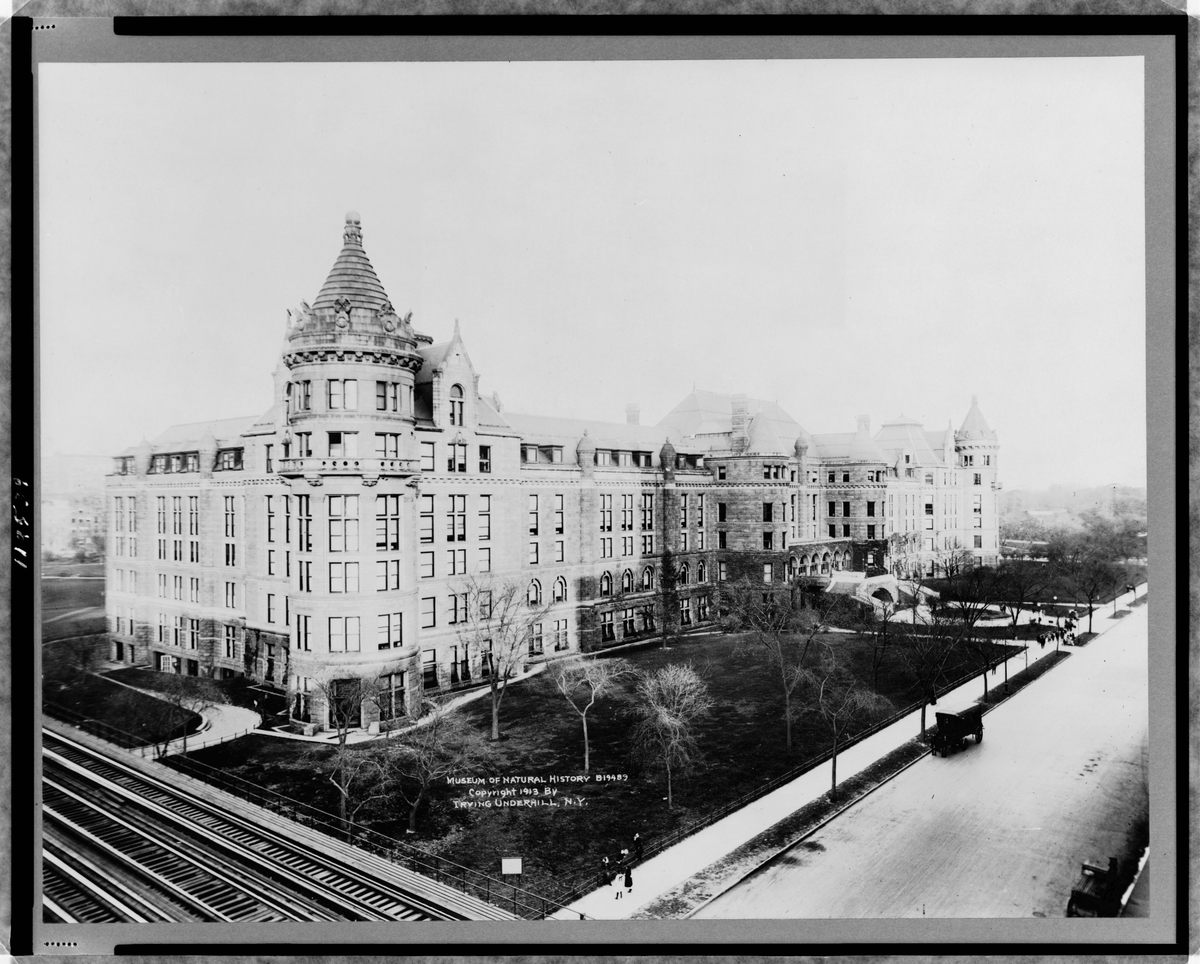
It was a joke, but just barely. The room was dim, and over the years the posts darkened, too. Because they sat exposed, instead of behind glass, staff members had tried to clean them over the decades using whatever they thought they ought to. “Well-meaning, all of it, I’m sure,” Alderson says, “but the approaches have changed.” Damage collected in layers—dirt sandwiched between swaths of uneven cleaning and resin that turned the wood dark brown and gummy, and concealed, dulled, or muddled the bright original colors. Dust blew in through open windows, and settled. The massive poles were also easily within visitors’ reach, and not everyone kept their hands to themselves. Some scratched their initials into the wood; others popped their chewed gum into the the figures’ mouths.
The museum is now in the process of a major overhaul of the section, which will close to the public this winter and reopen in 2020. The $14.5-million project will brighten the place up, and “honor [anthropologist Franz] Boas’s vision,” Whiteley says. Boas was an early curator of the gallery, and his plan involved a radical departure from the mishmash of objects that had been common in museum displays at the time. At the turn of the 20th century, many encyclopedic collections grouped objects by type—all the boats in one room, all the masks in another—and imposed a value judgement on the arrangement. (Newer, slicker objects were considered more advanced, and older ones were framed as evolutionary stages on the way to something better.) Boas imagined something else entirely, and organized displays by cultures instead of the size, shape, and material of the stuff they made.
Besides some minor cosmetic tinkering in the 1960s, Whiteley says, the current iteration of the hall is largely unchanged from 1910. But to restore a little of the luster to Boas’s mission, he adds, they must walk back some of the more recent additions. The murals depicting the imagined “noble savage” will be covered, Whiteley says, and “the alcoves dedicated to individual nations will remain that way, but with more emphasis on exchange and interchange of ideas.”
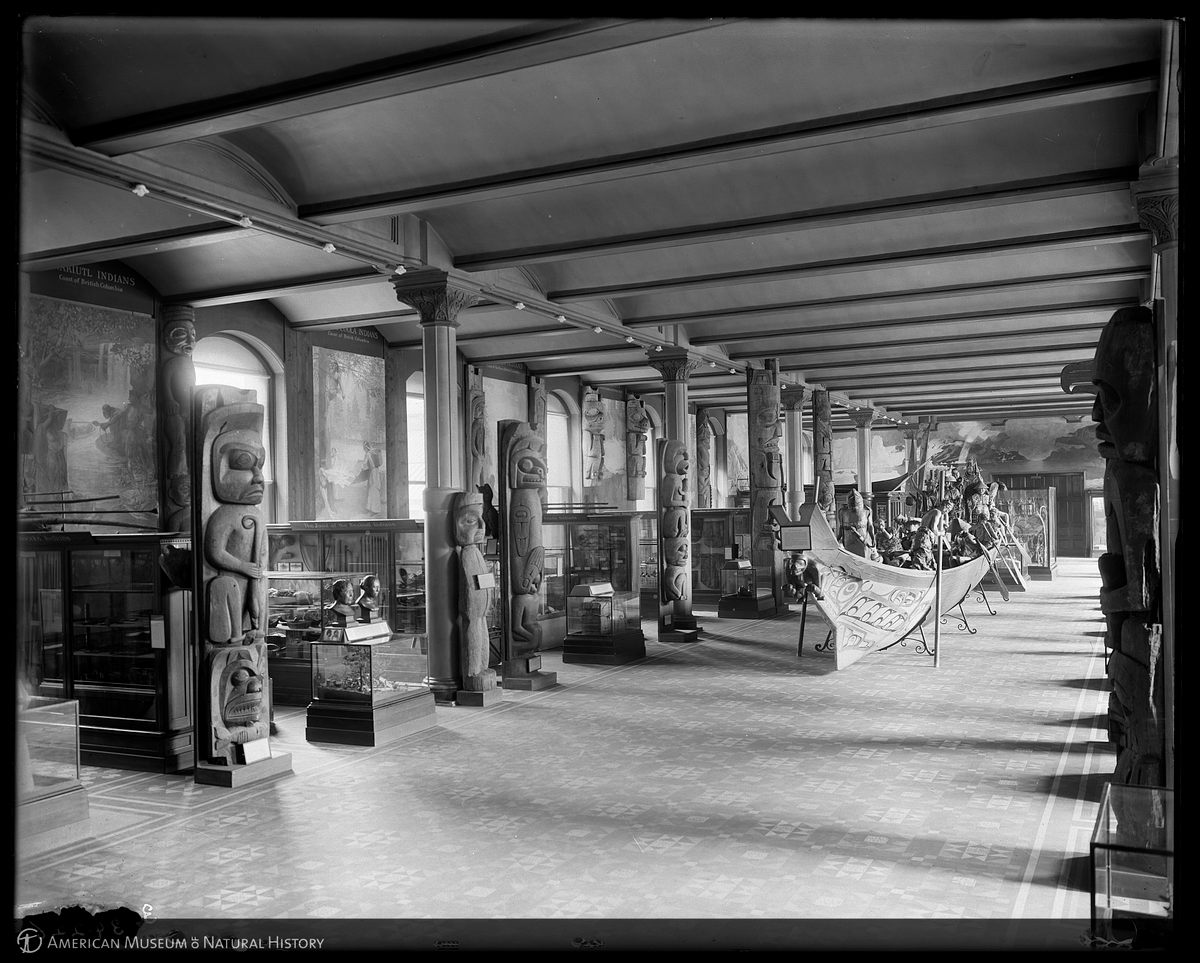
This may also involve contextualizing the collection in a new way, one that encourages visitors to reconsider the objects and the people who made them. Museumgoers may recognize a totem pole as a pile of creatures, without appreciating that they’re also storytelling tools that stand in front of the homes of village leaders as heralds and protectors, or that rise up to the beams of a clan house ceiling, narrating a family history. The renovation is bringing Native artists and historians to the museum for the first time in a formal capacity to provide more of this context and help grapple with stereotypes about Native communities and their ongoing political entanglements, over land, representation, schools, and more, says Haa’yuups/Ron Hamilton. Haa’yuups is a Nuu-chah-nulth artist and historian and head of the House of Takiishtakamlthat-h in western Canada, and is working alongside Whiteley as cocurator on the project.
Haa’yuups—who first visited the museum in 1967, at age 19, and has returned “every chance I get”—calls the hall “one of the greatest exhibits in the world that’s ever been put together about other people.” But, he says, it seems “frozen in time,” and doesn’t fully account for the fact that Native communities are still vibrant and, in many cases, still pushing for rights. (It wasn’t until 1960, for instance, that First Nations people in Canada could vote in federal elections without jeopardizing their treaty status.) “The fact that we don’t live in tepees, we don’t carry tomahawks, we don’t all have totem poles on our front porches—that needs to be said,” Haa’yuups says.

That ongoing conversation could also shed more light on these specific objects. Though these posts have lived in the museum for more than a century, there’s still uncertainty about their life before they arrived. As a rule, the items that arrived at the museum a little later have a better-preserved provenance. For later expeditions, “We have a village name, sometimes know it’s from this specific house, from this guy whose son is this, we’ll have a lot of information and sometimes a photograph of it before it was moved,” Alderson says. But for these posts, it’s been a question of “piecing things together over the years.” The staff knows that the posts shipped out of Port Simpson, a village in British Columbia now known as Lax-Kw’alaams, but for years, there wasn’t a firm consensus about which culture created them. Now, on the basis of curatorial research and input from Native advisors, the team is confident that the posts are Tsimshian.
Though some details of gallery plans are still being hashed out, Haa’yuups hopes that they will include new digital stations featuring Native people speaking for and about themselves, without an anthropologist as a middleman, and maybe a compilation of photographs by local artists, or newspapers written by and for the communities, emphasizing the beliefs and perspectives of people he says are often misrepresented.

Before the gallery reopens, it first has to be emptied, and each and every object will get fresh attention. The hall has held roughly 1,800 items, from the monumental to the miniature. The Haida canoe, 63 feet long, once hung from the ceiling, and then sat on the floor, while display cases held smaller tools. While some items are getting little more than a condition check or minor intervention—a bit of fresh paint, or a nearly invisible net to corral and smooth bits of fraying cedar bark—the totem poles require careful, intensive cleaning, “an inch-by-inch process,” Alderson says. “And going over areas not just once, but many times. You take off one layer of stuff, and then you go back in to do others.” And these giants also have to be cleaned exactly where they stand.
“Conservators are fairly used to working in open exhibition spaces, particularly if you’re working on large objects,” says Madeleine Neiman, the assistant conservator heading up the totem-cleaning team. “You go to the object—the object doesn’t come to you.”

The conservation staff was busy in the gallery one recent winter afternoon. Behind screens that cordoned her off from the few visitors who popped in to the gallery during the overhaul, Neiman stuck little rectangles of hydrogels to the posts and let them sit for 15 minutes or so. These work by “dewetting,” or coaxing the coating on the surface of the wood to release, Alderson says. Once that happens, it becomes easier to remove with a gentle rub with dry cotton. The team has also relied heavily on aqueous gels, which are microemulsions of solvents, chelators, and other components in a water base. These suspend tiny droplets of solvents at the surface, limiting what penetrates down into the paint or wood below.
Some of the visitors who did wander through stopped to toy with a kiosk that plays various sounds of the coast—a whistling wind, an eagle’s call, a spitting fire—on demand. Conservators raised and lowered themselves on a narrow lift, which beeped and bleated as though backing up in a warehouse. An announcement blared over a loudspeaker about an alarm ringing somewhere else in the building. “See how relaxing it is in here?” Alderson said. “That’s why they [the conservators] wear earphones all the time, so they can concentrate.”
The team works on the posts for six or seven hours at a stretch. It’s slow labor, and the effects are clear. Before Neiman tackled a crane, it was hard to see the feathers and eyebrows that have now emerged. Across the gallery, high up on a lift, assistant conservator Amanda Chau worked on another post. Back on the ground she recounted removing wads of brittle, decades-old gum from the surfaces with a silicone solvent and “a lot of different spatulas.”
“It’s gross,” Alderson added. “Satisfying, though!”
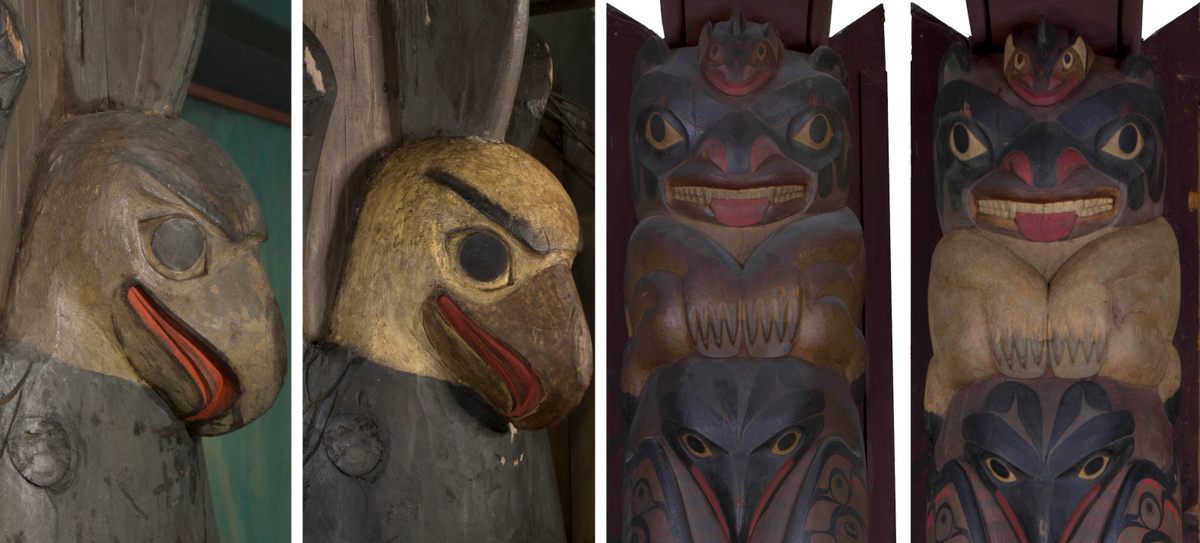
Though the work is wrapping up, “we haven’t removed all of the dirt and coating,” Alderson says. “Because we can’t.” In some areas, “the original paint, coating, and dirt are just one now.” A figure of an eagle was once soaked by a sprinkler that went off nearby, and the wood still shows signs of blanching, like a hazy, white-ish water ring on a coffee table. A bear’s belly looks like mottled fur, an accident of the interaction between between paint, old cleaning campaigns, and grime. “You can’t take one off without damaging what’s below,” Alderson says. The goal, where possible, is to celebrate the artistry by revealing obscured patterns, and then to stabilize the surfaces so that “little splintery bits” don’t snag vacuum brushes during future cleanings. When the team has done all they can, the poles will be wrapped and boxed, and work on the rest of the galleries will charge ahead. (For now, the old display cases, stripped bare of all but their headers—“Wood, Bone, and Stone”—look like presentation boards left over from an old science fair that was never fully cleaned up.)
When all is reassembled, Haa’yuups says, the posts will help tell the nuanced stories he wants visitors to know. “They’re among my favorite things,” he says. He loves the “chubby cheeks,” and the way the unknown carver captured the character of each creature. “They’re absolutely masterfully designed and carved—they’re the work of a genius,” he says. He also thinks the posts exemplify the qualities he wishes viewers would notice more often in Native art. The way the figures are interlinked shows “great problem-solving ability,” he says. “I think you’d have to be a fool to look at that and not see that they’re a work of great intelligence.”
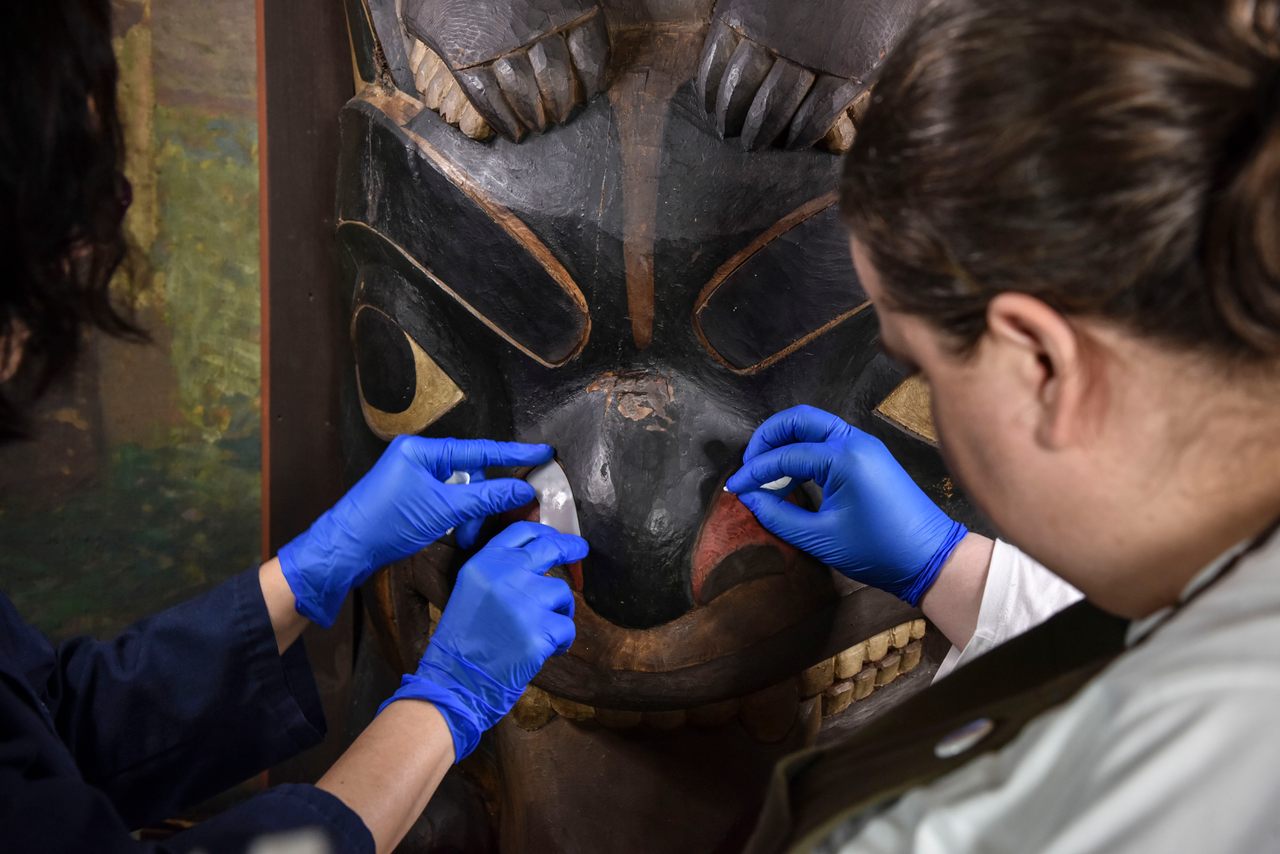





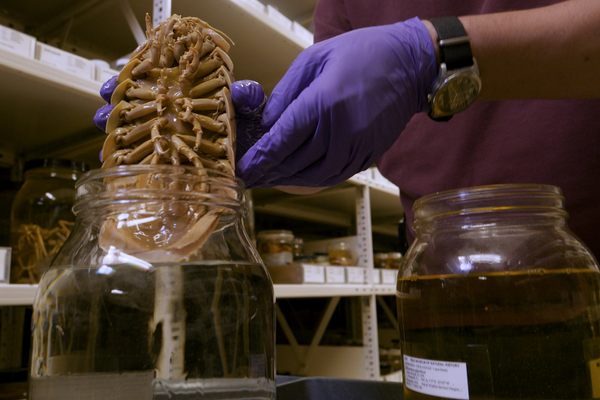























Follow us on Twitter to get the latest on the world's hidden wonders.
Like us on Facebook to get the latest on the world's hidden wonders.
Follow us on Twitter Like us on Facebook